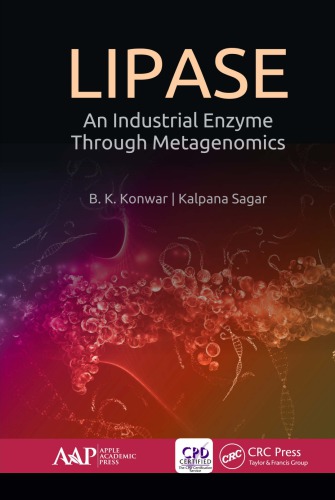Product desciption
Lipase An Industrial Enzyme Through Metagenomics B K Konwar Kalpana Sagar by B K Konwar; Kalpana Sagar 9781315159232, 9781771886185, 1315159236, 1771886188 instant download after payment.
Microbial lipases are industrially important and have gained their attention due to their stability, selectivity, and broad substrate specificity. Lipases are used as a medicine and also aid in indigestion, heartburn, allergy to gluten in wheat products (celiac disease), Crohn's disease, and cystic fibrosis. This new volume,Lipase: An Industrial Enzyme Through Metagenomics, considers the industrial demand for new sources of lipases with different catalytic characteristics that stimulate the growth and development isolation of new strains. The volume narrates the challenging metagenomic approach with the isolation of the lipase gene, its cloning intoEscherichia coli, culture of the recombinant bacteria, and extraction and assessment of the lipase enzyme.
Lipase-producing bacteria have been found in different habitats, such as industrial wastes, vegetable oil processing factories, dairy plants, and soils contaminated with oil and oil seeds among others. This volume is the effort of the authors to document the scientific findings carried out over the last eight years in the area of un-culturable soil microorganisms.
The book presents the physicochemical features of lipases and their specific applications in different commercial industries. The in-depth study looks at metagenomics for lipases from all angles and provides a truly informative resource. It describes the biochemical characterization of lipase enzymes with the high activity in the presence of 1% tributyrin. The book also highlights the maximum activity of the enzyme at temperature 37�C and pH 7.5 in the presence of the divalent cations Ca2+, Mn2+, Zn2+ and Fe2+. CTAB, gum arabic, NaCl and organic solvents like ethanol, 1-propanol, acetone, acetonitrile, glycerol and DMSO.
A wide review has been presented in the book on lipase enzymes purified from a large collection of microbes present in soil, seawater, waste-dumping sites, animal systems (including human beings), and the atmosphere. Stability of enzymes over changing environments of the industry is indeed a big issue, and the book deals at length with the changing temperatures and pH and metal ion concentrations. The book also highlights the antifungal and antibacterial activity of the lipase enzyme.


